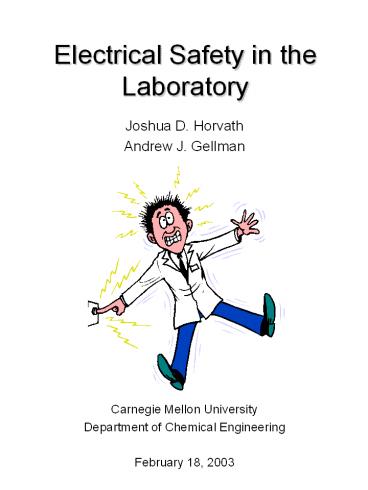Electrical Safety in the Laboratory - PowerPoint PPT Presentation
Title:
Electrical Safety in the Laboratory
Description:
Electrical Safety in the Laboratory Joshua D. Horvath Andrew J. Gellman Carnegie Mellon University Department of Chemical Engineering February 18, 2003 – PowerPoint PPT presentation
Number of Views:208
Avg rating:3.0/5.0
Title: Electrical Safety in the Laboratory
1
Electrical Safety in theLaboratory
- Joshua D. Horvath
- Andrew J. Gellman
- Carnegie Mellon University
- Department of Chemical Engineering
- February 18, 2003
2
Accidents
- Electrical shock from laser power supply
- Electrical shock from electrophoresis power supply
3
Introduction
- Relationship between power,
- current, voltage and resistance
- P power (watts)
- I current (amperes)
- V voltage (volts)
- R resistance (ohms)
- Example
- Heating tape uses 5 amps at 120 volts.
- Power dissipated by this device is 600 watts.
4
AC vs. DC Electricity
- Direct current (DC)
Alternating current (AC)
5
Electrical Components
- Capacitors
- Resistors
- Integrated circuits
6
Measuring Voltage
Connect Probe
Connect Probe
5V -
7
Safety Devices
- High Voltage Probe
- Connects to normal multimeter.
- Reduces voltage by factor of 1000.
- Should only be used with training or assistance.
- Dangerous if used improperly. You could be
KILLED.
8
Measuring Current (DC)
Connect Probe
Connect Probe
5V -
9
Safety Devices
- Clamp-on Ammeter
- Measures AC current through a single conductor.
- Does not work for DC current.
- If both wires (positive and negative) pass
through the clamp, no current reading is
possible.
10
Lab Equipment
- Power requirements (input)
Equipment Volts Amps Watts
PC 120 6.0 720
Monitor 120 1.5 180
Turbopump 120 4.0 480
Cryopump 240 12.0 2,880
Heating tape (big) 120 6.92 830
FT-IR 120 5.0 600
Heat gun 120 14.0 1680
11
Lethal Electricity
- Chart below assumes 1 second hand to foot
- exposure to 120 volt, 60 cycle AC power supply.
Current Reaction
1 mA Perception
5 mA Slight shock felt not painful but disturbing
6-30 mA Painful shock "let-go" range
50-150 mA Extreme pain, respiratory arrest, severe muscular contraction
1,000-4,300 mA Ventricular fibrillation
10,000 mA Cardiac arrest, severe burns and probable death
Laboratory wall outlets provide 20,000 mA !!
12
Safety Devices
- Fuses
- Protect electrical wiring from carrying too much
current. - Protect malfunctioning equipment from drawing too
much current. - Conductor melts if too much current flows through
fuse. - Can only be used once.
- Always use the correct fuse.
13
Safety Devices
- Circuit Breakers
- Protect electrical wiring from carrying too much
current. - Mechanical switch is driven by an electromagnet.
- Can only be reset many times.
14
Safety Devices
- Circuit Breakers (in action)
15
Safety Devices
- Circuit Breakers
- How much equipment can one 20A circuit breaker
handle? - Not enough to bake an entire vacuum chamber.
Device Current
Heat tape (1 inch by 8 feet) 6.92 A
Heat tape (1 inch by 8 feet) 6.92 A
Heat tape (1/2 inch by 5 feet) 2.58 A
Heat tape (1/2 inch by 10 feet) 4.33 A
Infrared lamp (inside chamber) 2.75 A
Total 23.5 A
16
Safety Devices
- Circuit Breakers
- One circuit breaker may cover many electrical
receptacles in a lab. - Receptacles in some labs are labeled with a
number that corresponds to a circuit breaker.
17
Preventing Accidents
- Avoid contact with energized circuits.
- Disconnect the power source before servicing or
repairing electrical equipment. - Work with only one hand, keeping the other hand
behind you or in a pocket. - If water or a chemical is spilled onto equipment,
shut off power at the main switch or circuit
breaker and unplug the equipment. - If an individual comes in contact with a live
electrical conductor, do not touch the equipment,
cord or person. - Disconnect the power source from the circuit
breaker or pull out the plug using a leather belt
.
18
Preventing Accidents
- Extension Cords
- Do not plug one extension cord into another
extension cord. - Do not exceed safety ratings.
- If cord is warm to touch, it is probably
overloaded.
Amperage 0-5 5-7 7-12 12-16 16-20
Cord length (feet) Wire gauges Wire gauges Wire gauges Wire gauges
25 50 75 100 150 200 18 18 16 14 12 12 18 16 14 12 12 10 16 14 12 10 14 12 10 12 10
Sizes smaller than wire gauge 10 are not normally available as flexible wire. Sizes smaller than wire gauge 10 are not normally available as flexible wire. Sizes smaller than wire gauge 10 are not normally available as flexible wire. Sizes smaller than wire gauge 10 are not normally available as flexible wire. Sizes smaller than wire gauge 10 are not normally available as flexible wire. Sizes smaller than wire gauge 10 are not normally available as flexible wire.
19
Preventing Accidents
- Electrical Fires
- Unplug equipment first.
- Use dry chemical fire extinguisher.
- If fire is large, unplug equipment and call fire
dept. - Never use water!!
20
Conclusions
- Be careful with electricity.
- Ask someone for help if you are unsure.































